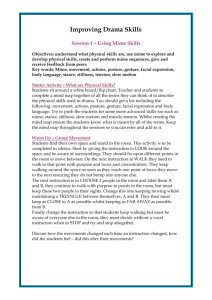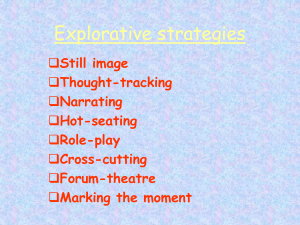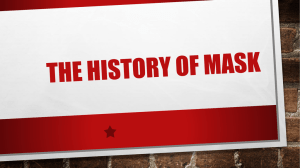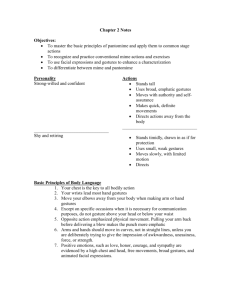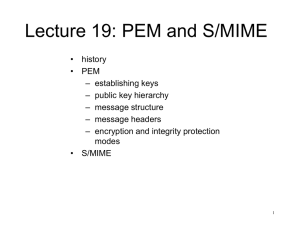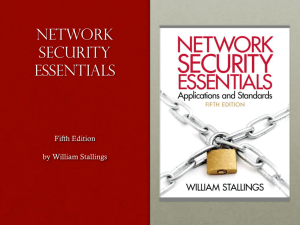The play of George Orwell`s Animal Farm
advertisement
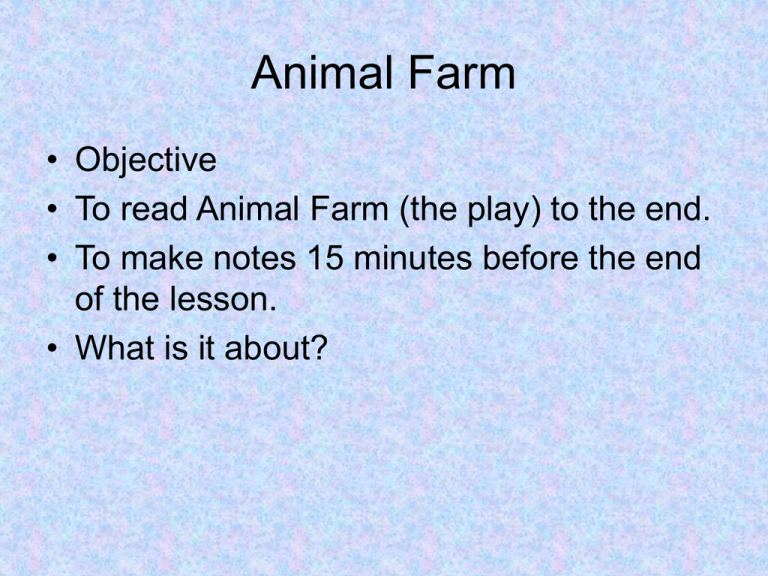
Animal Farm • Objective • To read Animal Farm (the play) to the end. • To make notes 15 minutes before the end of the lesson. • What is it about? Explorative strategies Still image Thought-tracking Narrating Hot-seating Role-play Cross-cutting Forum-theatre Marking the moment Mediums The The The The The The The The use use use use use use use use of of of of of of of of costume, masks and/or makeup sound and/or music lighting space and/or levels set and/or props movement, mime and/or gesture voice spoken language. Elements Action/plot/content Forms Climax/anti-climax Rhythm/pace/tempo Contrasts Characterisation Conventions Symbols At the end of each lesson. • All should be able to demonstrate and explain the strategy, medium or element explored in the lesson • Most of you should be able to understand and demonstrate the strategy, medium or element explored in the lesson, in detail. • Most will be able to give an example of how it/they could be used in the future. • Some will be able to give detailed reasons for the choices they make. Workshop 1 Hot seating character Narrating character, space, levels, content. Thought-tracking character, space The use of voice character, space (proximity) Levels and space Status of character, Action, Content. Action, Plot, Content, Characterisation (The means used to portray a role using vocal and physical skills) Objectives • Understand the characters of the play through hot-seating and voice. • Understand the plot and content through narration. • Explore the status of a character through space and levels and voice. • Identify the status of characters from Act 1, and to demonstrate the relationship between characters through still image, space and levels. Workshop 2 Marking the moment The use of space and levels The use of spoken language The use of sound and/or music Response Development Symbols Response/Development Characterisation Rhythm/pace/tempo Action, content, character, Objectives • Explore the use of symbols and sound to demonstrate emotion, action, setting and atmosphere. • Understand the cultural, social and historical context of the play through music. Workshop 3 Marking the moment The use of costume, masks and/or makeup The use of set and/or props The use of movement, mime and/or gesture Conventions Symbols Objectives • Understand how Movement, mime and/or gesture are part of demonstrating character, action, the relationship between characters, the scene and the story. • Use props/ set, costume, masks/makeup symbolically. • Understand what a dramatic pause is and how it affects a drama. • Develop the use of space and levels. Workshop 4 • • • • • • Role-play The use of lighting The use of movement, mime and/or gesture The use of spoken language. Climax/anti-climax Conventions (Using techniques such as slow motion, freeze frame, audience asides, soliloquy, split screen) • Contrasts E.g. (Quiet v Loud) Low v high) Response/Development-character and voice • Symbols Objectives • Explore the play and characters through role play and contrasts. • Explore the play and the characters through movement, mime and gesture. • Identify and demonstrate climax/anticlimax through strategies, mediums and elements. • Explore the use of lighting to create meaning within the play. Lighting Workshop 5 Marking the moment Thought Tracking Forum-theatre Cross-cutting The use of costume, masks and/or makeup The use of set and/or props The use of movement, mime and/or gesture anti-climax/ climax. Conventions Symbols Objectives • Explore character and story through thought tracking. • Explore various ways of marking the moment through Act 1. • Explore the play and the characters through Forum Theatre. • To know and apply cross-cutting to text WORKSHOP PREPARATIONS • The purpose is to prepare the ground work for the six workshops carried out in Unit 2. • 6 filmed hours of drama explorations under controlled assessment conditions. • Detailed notes of all work should be made.

